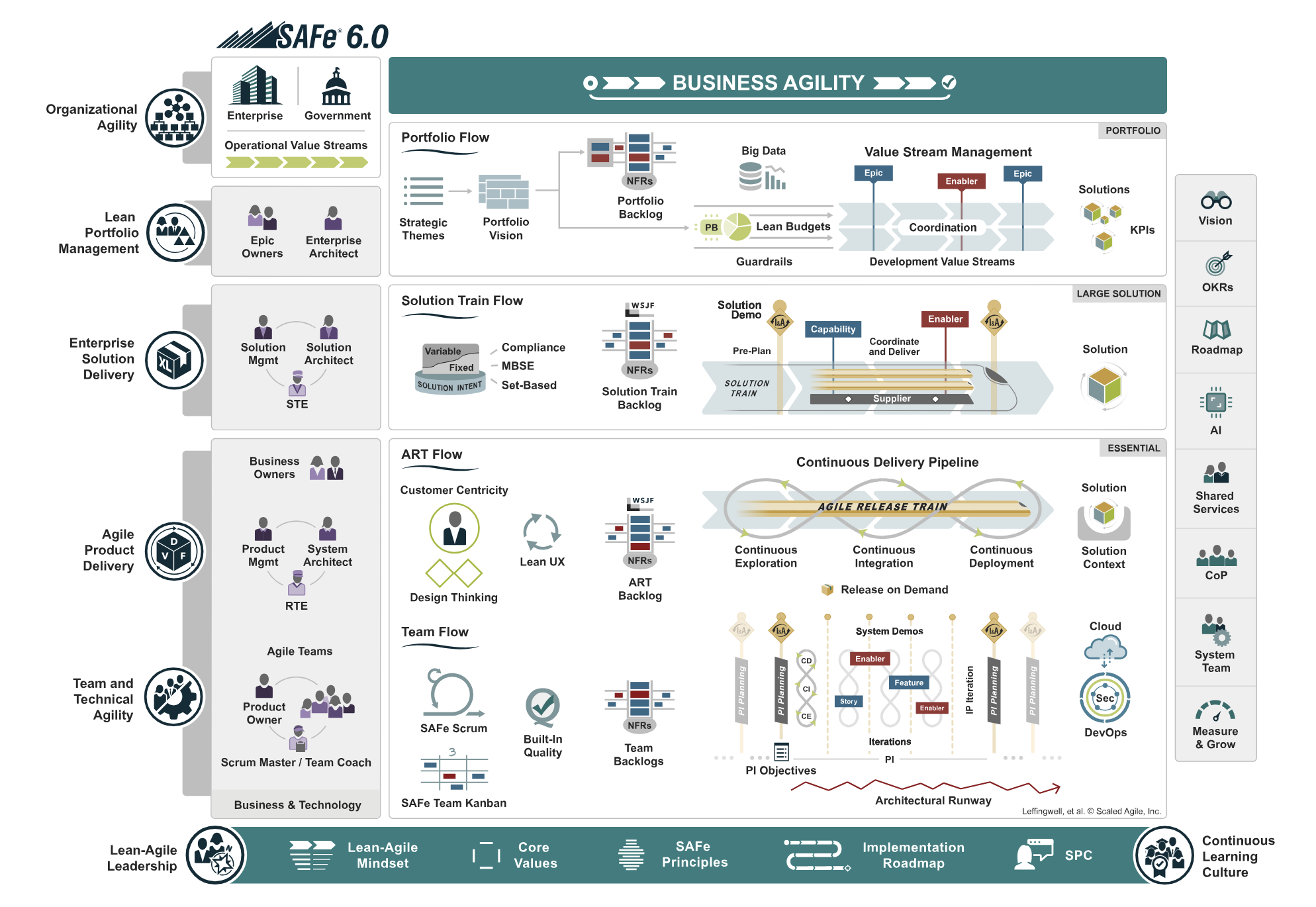What is SAFe?
Scaled Agile Framework (SAFe) is an agile software development framework designed to provide a structure for organizations to scale agile and lean methodologies across teams and departments. SAFe combines principles and practices from Agile, Lean, and DevOps into a comprehensive framework for large enterprises to achieve faster time-to-market, increased productivity, and improved quality.
Why should we use SAFe?
- Scalability: SAFe is designed for large organizations with complex systems. It allows for scaling agile practices across multiple teams and departments.
- Improved Alignment: SAFe promotes alignment and collaboration across different levels of an organization.
- Increased Productivity: Through the implementation of Lean and Agile principles, SAFe can lead to increased productivity, faster delivery times, and better quality products.
- Risk Reduction: SAFe allows for early identification and mitigation of risks, reducing the chances of project failures.
Where should we use SAFe?
SAFe should be used in large-scale product development environments where multiple teams are required to coordinate and collaborate. This includes large organizations or companies that are transitioning from traditional project management methodologies to more agile practices and need a structure to manage the transition.
7 Core Competencies of SAFe
- Enterprise Solution Delivery: This competency enables the building of world-class solutions via applying Lean-Agile principles and practices across all levels in the enterprise.
- Agile Product Delivery: It is a customer-centric approach to product development, focusing on delivering valuable products in short, deliverable cycles.
- Team and Technical Agility: This involves high-performing Agile teams who use good technical practices, such as Agile modeling, to deliver high-quality, functional software regularly.
- Lean Portfolio Management: This competency aligns strategy and execution by applying Lean and systems thinking approaches to strategy and investment funding.
- Organizational Agility: This competency enables quick and effective responses to opportunities and threats using Lean and Agile practices.
- Continuous Learning Culture: This competency encourages a culture of innovation and relentless improvement.
- Lean-Agile Leadership: Leaders lead by example, guiding teams in adopting and practicing the principles and practices of Lean and Agile.
What is Agile Release Train (ART)?
Agile Release Train (ART) is a key component of the SAFe framework. It represents a long-lived team of Agile teams, which, along with stakeholders, incrementally develop, deliver, and validate a system in fixed timeboxes known as Program Increments (PIs).
Roles in SAFe Framework?
Key roles in the SAFe framework include:
- SAFe Program Consultant (SPC): Trains others in SAFe roles and helps in the deployment of SAFe.
- Release Train Engineer (RTE): Acts as a servant leader and coach for the ART.
- Product Manager: Responsible for defining and supporting the program vision.
- System Architect/Engineer: Provides architectural guidance and technical enablement to the teams on the ART.
What are PI and PI planning?
Program Increment (PI) is a timebox during which an Agile Release Train delivers incremental value in the form of working, tested software and systems. PI Planning is a two-day, face-to-face event where all members of the ART collaboratively plan the upcoming Program Increment.
What is Program Board, and How to use it?
The Program Board visualizes the feature flow and dependencies across the teams in an Agile Release Train. It is used during PI Planning to identify dependencies and is updated throughout the PI to reflect the current state of Feature delivery.
How Effectively apply I&A (Inspect and Adapt)?
Inspect and Adapt (I&A) is a significant event held at the end of each PI, where the ART reflects on the past increment and identifies areas of improvement.
What is Solution Train, and why do we need it?
A Solution Train coordinates multiple Agile Release Trains and suppliers to streamline the development, deployment, and release of large, complex solutions. It’s needed when the product or solution’s scope is beyond a single ART’s capability to develop and deliver.
What is the importance of Lean-Agile Leadership and Lead by Example approach?
Lean-Agile Leadership helps create a culture that supports the adoption and implementation of SAFe. Leaders lead by example, exhibiting the behavior they want to see in the rest of the organization and promoting a culture of continuous learning, innovation, and relentless improvement.
What are the alternatives to SAFe?
Some alternatives to SAFe include Disciplined Agile Delivery (DAD), Large-Scale Scrum (LeSS), and Nexus, among others. Each of these frameworks has its strengths and weaknesses and may be more appropriate depending on the specific context and needs of the organization.
Conclusion
The Scaled Agile Framework (SAFe) provides a powerful set of tools for large organizations that need to scale Agile practices across multiple teams and departments. While it may not be the right fit for every organization, its principles, and practices can provide significant benefits, including improved productivity, alignment, and risk management. Like any framework or methodology, its success depends largely on how well it is understood and implemented.
References
https://scaledagileframework.com/safe/
Thanks,
Onur Baskirt

Onur Baskirt is a Software Engineering Leader with international experience in world-class companies. Now, he is a Software Engineering Lead at Emirates Airlines in Dubai.

